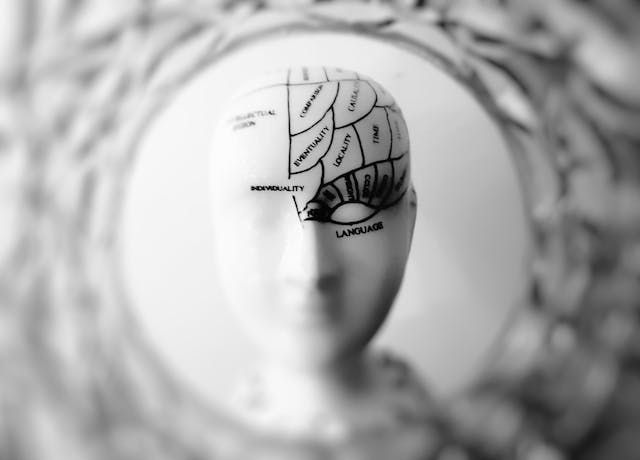
Have you ever experienced the strong desire to forge your own path, only to hesitate for fear of losing your faith or alienating yourself from your community? Do you wrestle with doubts about the legitimacy of your emotions or find it challenging to rely on yourself? Perhaps you've also encountered situations where affection or gratitude felt strangely detached or unreachable. Such experiences are not uncommon for individuals grappling with the aftermath of religious trauma, where the path to self-discovery often feels fraught with conflict between personal growth and communal belonging.
Understanding Religious Trauma
Religious trauma is a deeply impactful form of emotional and psychological injury. It is trauma that arises from harmful experiences within a religious context. Individuals may suffer from religious trauma due to a variety of reasons. These may be exposure to toxic doctrines, manipulation, spiritual abuse, or the rejection by their faith community. This trauma often manifests as intense feelings of guilt, profound shame, or pervasive fear. A person can feel an enduring loss of trust in both oneself and in higher powers.
The damage inflicted by religious trauma can profoundly affect one’s emotional well-being. Its can lead to a disconnection from personal emotions and a pervasive sense of unworthiness. Such experiences challenge the core of an individual's identity and beliefs, creating inner turmoil and conflict that can persist without intervention. In some settings, the symptoms of religious trauma can be similar to those of complex post-traumatic stress disorder (C-PTSD).
An Introduction to Internal Family Systems (IFS)

Internal Family Systems (IFS) stands out as a revolutionary psychotherapeutic approach designed to foster self-awareness and healing. It has a wide range of applications that can be used in healing trauma. At its core, IFS posits that the mind is naturally segmented into multiple sub-personalities, or "parts." These parts each have their unique viewpoints, emotions, and memories. They often take on distinct roles within the psyche, such as protectors, managers, and exiles.
Each of these categories plays a pivotal role in our mental ecosystem. Protectors and managers work to shield the individual from pain and maintain daily function. Exiles carry burdens of trauma and pain. Both of these examples are frequently a result of adverse experiences such as religious trauma.
What sets IFS apart is its holistic focus on the individual's "Self," the essence of who they are beyond their parts. The Self is characterized by its innate capacity for compassion, clarity, courage, and connectedness. Through the IFS process, individuals are encouraged to assume a leadership role within their internal system, guiding their parts with kindness and understanding. This therapeutic journey involves identifying and addressing the parts that have been hurt or have taken on extreme roles due to religious trauma, thereby restoring balance and promoting psychological healing. By fostering an internal environment of empathy and acceptance, IFS enables individuals to embark on a path toward lasting recovery and self-discovery, transforming the way they relate to themselves and their past experiences.
How IFS Addresses Religious Trauma
In the context of healing from religious trauma, IFS offers a powerful and empathetic approach. It facilitates a deep connection with the wounded parts of the psyche that harbor the scars of religious abuse, neglect, or misunderstanding. Through IFS, individuals learn to approach these vulnerable aspects of themselves with the compassion and empathy they might have been denied in their religious experiences. By fostering an environment where no part is judged and every feeling is validated, the process enables the person to safely explore the impact of their trauma.
Importantly, IFS assists in distinguishing between one's faith and the harmful interpretations or applications of it that caused pain, allowing for a nuanced understanding of one's beliefs and values. This nuanced exploration encourages the reevaluation of beliefs in a way that honors one's inner truth and facilitates a healing reconnection with one’s spiritual self. As such, IFS does not seek to change one’s relationship with their faith directly but rather to heal the internal wounds inflicted by traumatic religious experiences. This approach empowers individuals to redefine their spiritual path on their own terms, leading to a more authentic and fulfilling spiritual life.
The Role of the Self in Healing

In the healing journey through IFS, the Self is instrumental, acting as an internal healing agent that navigates and integrates the various parts of an individual's psyche. This pivotal role involves leveraging the Self's inherent qualities of compassion, clarity, courage, and connectedness to embrace and soothe the parts that have been damaged or are carrying heavy burdens due to religious trauma.
The engagement of the Self allows for a unique therapeutic dialogue within the person, where wounded parts are heard, acknowledged, and understood without judgment.
Through this process, individuals discover an internal safe space where they can address their trauma directly, offering the wounded parts the empathy and acceptance they may have missed. This empowerment by the Self fosters a profound internal healing environment, promoting a reconciliation of conflicting internal elements and leading to a harmonious state of being. Engaging the Self in this manner not only facilitates the healing of religious trauma but also enhances the individual’s overall resilience, self-esteem, and emotional equilibrium.
Practical Steps to Begin Healing with IFS
Embarking on the healing journey with Internal Family Systems (IFS) in the wake of religious trauma requires a thoughtful approach. Your first step should be seeking out a qualified therapist skilled in IFS, with a strong background in addressing religious trauma. This professional can guide you through the nuanced process of getting acquainted with your internal parts, especially those carrying the weight of your trauma. They'll facilitate conversations that enable you to approach these parts with curiosity, compassion, and empathy.
Engaging in regular therapy sessions provides a structured environment where you can safely explore the depths of your experiences and begin the process of healing. Additionally, engaging in self-led IFS exercises, recommended by your therapist, can deepen your understanding and foster an ongoing dialogue with your internal family. Journaling about your thoughts, feelings, and discoveries after each session can also enhance your healing journey, providing clarity and insight into your progress. Embracing this path with patience and an open heart will gradually illuminate the way to reconciliation and peace within yourself, allowing you to redefine your spiritual beliefs and identity on your own terms.

Art therapy is a powerful tool that often goes unrecognized in the world of mental health treatment. This form of therapy utilizes the creative process of making art to improve a person's physical, mental, and emotional well-being. When traditional talk therapy fails to adequately address deep-seated trauma, art therapy steps in to provide a unique outlet for expression and healing. In this blog post, we will explore the role of art therapy in the context of Eye Movement Desensitization and Reprocessing (EMDR) therapy, a widely-used approach for treating trauma and other psychological issues.
Understanding Art Therapy and Its Foundations
At its core, art therapy is built on the premise that engaging in the act of creating art is inherently therapeutic. It can foster personal growth, healing, and mental wellness. This therapeutic discipline offers a distinctive path for individuals to delve into their subconscious. Art enables them to uncover and address emotions and conflicts that might be challenging to express through words alone. It operates on the understanding that the creative process, as a form of nonverbal communication, has the unique capacity to reveal and work through complex emotional experiences.
\As participants navigate through various art-making techniques, they are provided with the opportunity to visualize their emotional landscape, guided by an Art Therapist. Hopefully, this may lead to profound insights and transformative healing experiences. This approach to therapy is especially beneficial for individuals who find conventional verbal communication limiting. Some people may feel it is even inadequate in expressing the depth of their internal experiences. Through art, they are able to articulate the inexpressible, facilitating a deeper connection with their own emotional realities, making it great for those struggling with words.
The Synergy Between Art Therapy and EMDR Therapy

The convergence of art therapy and EMDR creates a powerful alliance for tackling mental health issues like PTSD and anxiety, fitting different individual needs. This integrated approach facilitates a deeper engagement with the therapeutic process. It allows clients to unlock and process traumatic memories in a multifaceted manner.
While EMDR therapy focuses on desensitizing and reprocessing memories through bilateral stimulation, art therapy adds a layer of expressive richness. It provides a visual and tactile medium through which clients can explore and articulate their experiences.
The synergy of these therapies enhances emotional insight and healing. This is done by leveraging the strengths of each modality. EMDR's structured approach to trauma processing is complemented by the fluid and expansive nature of artistic expression. This combination broadens the avenues for understanding and healing, as well as caters to diverse needs and preferences, making therapy accessible to more individuals. By melding the cognitive with the creative, this integrated therapeutic approach opens up a dynamic space for healing, where emotions and memories can be navigated in a holistic and person-centered manner.
Art Therapy as a Safe Haven for Emotional Expression
Art therapy creates a nurturing and secure environment that enables individuals to delve into and express complex emotions with ease and without judgment. This method supports clients in accessing and articulating feelings that are otherwise hard to reach through more conventional therapeutic approaches. The process of making art in itself can be a profoundly healing act, offering a unique way to express emotions that might not be fully understood or verbalized. It invites an exploration of one's inner self, allowing for a non-verbal dialogue between the conscious and subconscious.
Through various artistic mediums, individuals can portray their emotions, experiences, and memories. Doing this fosters a sense of ownership and control over their healing journey. The tactile experience of handling art materials can also be soothing and grounding, providing a physical way to manage and express difficult emotions. In this respect, art therapy stands as a beacon of hope and solace for those navigating the complexities of healing from trauma. It can offer a path towards emotional clarity and relief that transcends the limitations of spoken language.
Enhancing the EMDR Process Through Art

Incorporating art therapy into EMDR therapy serves as a bridge to further facilitate the processing of traumatic memories. This integration allows individuals to symbolically represent their trauma, emotions, and recovery journey through art, offering a visual language for what might be too difficult to articulate with words. By engaging in artistic creation, clients can externalize their internal emotional struggles, making them more tangible and manageable.
This aids in the desensitization phase of EMDR and enriches the reprocessing phase. Clients can visually map out and reframe their experiences. The interplay between visual art and EMDR techniques fosters a comprehensive healing environment that honors both the cognitive and creative aspects of recovery. Through the use of art, individuals are empowered to navigate their healing process with a renewed sense of agency and creativity. It can potentially unlock deeper levels of emotional insight. This innovative approach underscores the adaptability and resilience of the human spirit. It offers a profound medium for transformation and growth within the context of trauma therapy.
Practical Approaches to Integrating Art Therapy with EMDR
To effectively weave art therapy into the framework of EMDR therapy, therapists can employ a variety of strategies tailored to enhance the therapeutic experience and foster deeper emotional healing. One practical approach involves inviting clients to engage in art-making activities directly before or after an EMDR session. This technique can serve as a powerful tool for clients to prepare mentally and emotionally for EMDR or to decompress and process their feelings afterward.
During EMDR sessions, therapists might also introduce art-based interventions. This is done as a means to facilitate the expression and processing of difficult emotions that arise. For instance, clients may be encouraged to draw or paint their emotional responses to EMDR prompts. Doing the art allows them to capture and explore their feelings in a tangible form. Additionally, art can be used to symbolize the transformation of negative beliefs into positive ones, helping clients visualize their journey towards healing in a concrete way.
Another approach includes utilizing art as a medium for clients to express their narrative or story. It provides a visual representation of their trauma and its impact on their life. This can be particularly useful in the reprocessing phases of EMDR, where understanding and reframing of past experiences is crucial.
By incorporating these practical art therapy techniques within EMDR sessions, therapists can offer a multi-layered healing experience that addresses the emotional and cognitive aspects of trauma, fostering a deeper, more holistic recovery process.

In the midst of a highly polarized political climate, many individuals across the nation find themselves grappling with heightened levels of voter anxiety and election anxiety. The constant barrage of news coverage, social media discussions, and political debates can leave individuals feeling overwhelmed, stressed, and uncertain about the future. As we approach the upcoming US Presidential Election, it is crucial to address the mental health impact of this turbulent period and explore strategies to mitigate voting anxiety for a restful night.
Understanding the Impact of a Polarized Political Climate on Mental Health
The heightened state of polarization in the United States' political sphere has undeniably ushered in a wave of increased anxiety amongst the electorate. Election anxiety is real, and it can induce everything from insomnia to panic attacks. Anxiety levels rise in the lead-up to an election, peak on election day, and then fall slightly afterward. This era, characterized by sharply divided opinions and relentless streams of often conflicting information, casts a long shadow over individuals' mental health. The relentless exposure to divisive rhetoric and the high stakes attached to political outcomes can foster a breeding ground for stress, fear, and uncertainty. Individuals may find themselves ensnared in a web of worry, attempting to decipher complex political narratives that seem to shift with the wind. This constant state of vigilance, of parsing through information to unearth truth from fiction, exacts a heavy toll on one’s peace of mind.
Amidst this tumultuous backdrop, the emotional and psychological ramifications are palpable. The ceaseless uncertainty and the barrage of polarized viewpoints can lead to a pervasive sense of unease. This can affect an individuals' ability to focus, make decisions, and maintain a sense of normalcy in their daily lives. This psychological strain is not merely fleeting. It seeps into the fabric of one's day-to-day existence, potentially exacerbating pre-existing conditions of anxiety. This all contributes to a heightened state of alertness that wears on the psyche.
In navigating this polarized landscape, the challenge then becomes one of finding a delicate balance - a means to remain informed and engaged without allowing the political climate to overwhelm one's mental equilibrium. It is a tightrope walk of consuming information judiciously, recognizing the impact of political polarization on mental well-being, and taking steps to safeguard one's inner peace amidst the clamor.
The Consequences of Turning Away from Political Engagement

While the allure of retreating from the political fray to shield one's mental health might seem appealing, such a decision carries its own set of repercussions. Individuals who choose to step back from political engagement, driven by a desire to evade the stress and anxiety that often accompanies election seasons, may inadvertently diminish their ability to influence decisions that affect societal and personal realms.
The act of disengaging not only distances them from critical information that could inform their choices and actions but also risks leaving a vacuum where their voices and perspectives are sorely needed.
In a society where every vote and every opinion can contribute to shaping the future, withdrawing from the electoral process can lead to a sense of disconnection and powerlessness. This feeling of being adrift, of lacking agency in the face of significant societal shifts, can exacerbate feelings of anxiety rather than alleviate them. Moreover, this withdrawal from political engagement forfeits the opportunity to be part of constructive change, potentially leaving individuals feeling even more alienated from their communities and the decisions that shape their lives.
The consequences of turning away from political engagement thus extend beyond the individual, affecting the broader fabric of society. When individuals opt out of participating in the democratic process, the diversity of voices that enriches and informs democratic debate diminishes. This reduction in engagement can lead to a less representative and inclusive political landscape, one in which the concerns and needs of various segments of society may not be adequately addressed or heard.
Striking a Balance: Engaging with Care
In the quest to find equilibrium amid the electoral storm, individuals are discovering innovative strategies to manage voting anxiety, ensuring that their engagement with the political process does not come at the expense of their mental health. One critical approach involves a discerning consumption of news, where the focus is on reliable, fact-checked media. This deliberate choice helps mitigate the overwhelming influx of information and the accompanying stress, providing a clearer, more grounded understanding of the political landscape. By limiting exposure to sensationalized narratives and seeking out sources that prioritize accuracy over alarm, individuals can remain informed without being inundated by the constant churn of the news cycle.
Furthermore, this careful engagement extends beyond media consumption to the very essence of civic participation. It encompasses a thoughtful approach to conversations around politics, recognizing the value of empathy and respect in dialogue. In recognizing the diverse perspectives within one's community, there emerges an opportunity to foster connections rather than divisions, even amidst differing viewpoints. This balanced engagement offers a pathway to navigate the charged political atmosphere with a sense of purpose and calm, rather than succumbing to the fray.
Through these measured steps, the act of engaging politically transforms into a practice of self-care, rather than a source of distress. It becomes a testament to the possibility of staying informed and involved, while also safeguarding one's mental and emotional well-being. In this way, individuals can contribute to the democratic process without compromising their peace of mind, navigating the complexities of the current political climate with intention and care.
Prioritizing Self-Care and Mental Well-being

In the whirlwind of election seasons, when the air is thick with debate and the pressure of political outcomes weighs heavily, the importance of self-care becomes paramount for individuals striving to maintain mental well-being. Engaging in self-care practices is not an act of indulgence but a crucial step in ensuring resilience and stability amidst external turmoil.
Individuals find solace in activities that ground them, be it through meditation that quiets the mind, deep breathing exercises that restore balance, or gentle yoga that reconnects the body and spirit. These practices serve as a sanctuary, offering a respite from the relentless pace of political discourse.
Moreover, the foundation of mental well-being is often fortified by the pillars of sleep, nutrition, and physical activity. A commitment to obtaining a restful night's sleep, consuming nourishing foods, and partaking in regular exercise forms a protective barrier against the stressors of the political climate. Such practices not only enhance physical health but are instrumental in mitigating feelings of anxiety and fostering a sense of inner peace.
In a time when external forces seem beyond one's control, prioritizing self-care and mental well-being becomes an act of empowerment. It is a deliberate choice to carve out spaces of tranquility and nurture resilience, ensuring that individuals remain steadfast, not only in the face of the current political maelan, but in all challenges that life may present.
Navigating Conversations and Relationships in a Polarized Environment

In an era where political divisions run deep, individuals often find themselves at a crossroads in conversations and relationships. This may lead to differing views which can easily escalate into conflict. Political party has become a strong social identity. Election anxiety is impacting friendships, families, and even personal mental well-being.
The art of maintaining harmony within these interactions lies in the cultivation of empathy and open-mindedness. It demands a willingness to listen actively, fostering an environment where divergent perspectives are not just tolerated but valued for the depth they add to the dialogue.
Setting healthy boundaries emerges as a critical skill, enabling individuals to engage in meaningful discussions without compromising their emotional well-being. By establishing limits on the nature and extent of political discussions, individuals can protect their mental space. This can ensure that exchanges remain respectful and constructive.
The pursuit of common ground is another vital strategy. It encourages focusing on shared values and goals, rather than fixating on the points of disagreement. This approach not only bridges divides but also strengthens connections, affirming that at the heart of many relationships lies a mutual desire for understanding and respect.
In navigating these interactions, individuals foster a climate of mutual respect. Conversations between these individuals are seen as opportunities for growth and connection. Through this mindful approach, relationships can thrive, even amidst a landscape marked by polarization. It can nurture a sense of unity in an otherwise divided world.
Moving Forward with Resilience and Hope

As society continues to traverse the choppy waters of the current political climate, the embodiment of resilience and hope stands as a guiding light for many. The cultivation of these qualities, deeply intertwined with the conscious efforts to manage mental health and prioritize self-care, illuminates a path forward through the tumult. It is within this journey that individuals discover the strength to face the uncertainties of the political landscape with a steadfast heart and a clear mind. Engaging with the world around them with empathy and thoughtful consideration allows for a compassionate dialogue that transcends division. It fosters a sense of community and shared purpose.
This commitment to navigating challenges with grace and optimism nurtures personal growth and contributes to the collective well-being of society. In embracing a future marked by resilience and hope, individuals can find solace in their ability to adapt and thrive. This can be regardless of the external environment. This forward movement, powered by a collective desire for understanding and connection, heralds a brighter, more inclusive future where dialogue and empathy pave the way for healing and unity.

For many individuals in the LGBTQIA+ community, the journey of transitioning can be a tumultuous one. A journey filled with a range of emotions including anxiety and depression. The process of coming to terms with one's gender identity, undergoing hormone replacement therapy (HRT), and potentially having surgeries can be overwhelming. However, there is a therapeutic approach that may offer relief and help individuals feel more connected with their mind and body. It is called Eye Movement Desensitization and Reprocessing (EMDR) therapy.
Understanding the Emotional Terrain of Transitioning
Transitioning, for many within the LGBTQIA+ community, represents not only a journey of physical metamorphosis but also of profound emotional exploration and self-discovery. This path, while ultimately affirming, is often fraught with complex feelings that can challenge even the strongest among us. As individuals embark on this deeply personal quest to align their outer selves with their inner truth, they may confront a myriad of societal pressures and internal conflicts that can exacerbate feelings of anxiety and depression.
The emotional landscape of transitioning is intricate and varied. It can encompass the excitement and hope of becoming more authentically oneself. It also comes with the fear and uncertainty that change inevitably brings. This anticipation of achieving congruence in one’s gender identity can be shadowed by the dread of potential isolation, misunderstanding, and discrimination. These external pressures compound the internal struggle, making it difficult for some to navigate the process of self-acceptance and self-love.

Complicating this journey further are the obstacles to finding affirming support and understanding. Misconceptions and stigma about what it means to transition can leave individuals feeling isolated and invalidated. This can intensify feelings of anxiety and depression. The daunting task of explaining one’s identity to others, fear of rejection, and the constant battle against societal norms and expectations can be overwhelming, leading to a profound sense of loneliness and despair.
As such, the emotional terrain of transitioning is marked by highs and lows. This can range from moments of exhilarating clarity as well as painful doubt. The process requires incredible resilience and courage, as individuals navigate through this complex emotional landscape in pursuit of their true selves. While the journey is inherently challenging, understanding and acknowledging these emotional experiences are crucial steps toward healing and growth.
An Introduction to EMDR Therapy
Eye Movement Desensitization and Reprocessing (EMDR) therapy emerges as a compelling psychotherapeutic approach. It is particularly renowned for its efficacy in addressing trauma-related conditions. EMDR facilitates the processing of distressing memories and emotional pain by activating both hemispheres of the brain through bilateral stimulation. This bilateral stimulation can be guided eye movements or tactile tapping. This innovative method aims to assist individuals in reorganizing and reinterpreting memories and emotions that are at the root of their psychological distress.
Developed in the late 1980s, EMDR has rapidly evolved and garnered empirical support as a treatment for various manifestations of psychological distress. Its unique methodology involves eight distinct phases, guiding clients from history-taking to the processing of traumatic events, and culminating in the consolidation of adaptive coping mechanisms. During EMDR sessions, therapists work closely with clients to identify specific distressing memories. They also help to identify negative beliefs about themselves that are associated with these memories. Through the structured phases of EMDR, clients are encouraged to focus on these memories while simultaneously engaging in bilateral stimulation. This dual focus facilitates the brain's natural healing process. This allows for the emotional charge of the memory to be diminished and for a more adaptive, empowering narrative to emerge.
Importantly, EMDR therapy goes beyond mere symptom relief, striving to foster a holistic sense of healing. Clients often report a decrease in distress related to specific memories and an overall improvement in their well-being. This gives room for an increased capacity to engage in their lives more fully. By directly targeting the underlying emotional impact of traumatic and distressing experiences, EMDR holds promise as a transformative therapeutic modality, especially for those contending with the profound emotional complexities associated with transitioning. Through its structured yet flexible approach, EMDR offers a pathway to healing that is both scientifically grounded and deeply attuned to the individual's psychological landscape.
EMDR in Action: Healing from Gender Dysphoria

EMDR therapy emerges as a vital resource for those grappling with gender dysphoria. Gender dysphoria is a condition characterized by profound discomfort due to a discrepancy between one’s experienced gender and the gender assigned at birth. This discomfort often manifests as severe anxiety, depression, and a disconnection from one’s body. In navigating these turbulent emotions, EMDR offers a promising avenue for healing and self-discovery.
Through its structured approach, EMDR targets the distressing memories and negative self-perceptions that underpin gender dysphoria. Individuals may harbor deep-seated beliefs of not belonging, being misunderstood, or feeling inherently flawed due to their gender identity struggles. EMDR engages the brain’s natural healing processes, allowing individuals to reprocess these painful experiences and beliefs. By focusing on specific memories or thoughts while receiving bilateral stimulation, clients can start to dissociate the negativity, shame, or fear attached to these memories. It can pave the way for more affirmative and empowering narratives about their gender identity.
The therapy’s unique ability to delve into the layers of emotional pain and cognitive dissonance that accompany gender dysphoria makes it an invaluable tool. It assists in alleviating the acute distress associated with living in a body that feels incongruent with one’s gender identity. As these individuals process their experiences through EMDR, they often find that the emotional charge of their distressing memories diminishes. This reduction in emotional intensity can lead to a significant decrease in anxiety and depression levels. It can ultimately contribute to a more harmonious internal experience.
As part of a comprehensive treatment plan, EMDR facilitates a journey towards self-acceptance and body congruence. It helps individuals in the LGBTQIA+ community to not only reconcile their past experiences with their gender identity but also fosters a stronger, more positive connection with their bodies and selves. Through EMDR, the path to healing from gender dysphoria becomes more accessible. It, empowers individuals to embrace their true identity with confidence and peace.
The Role of EMDR in Overcoming Anxiety and Depression
EMDR therapy stands out as a potent intervention for mitigating the profound impacts of anxiety and depression. This is particularly poignant for those undergoing the transition process. This therapeutic modality dives deep into the psyche, addressing the root causes of these mental health challenges. Through the distinctive mechanism of bilateral stimulation, EMDR aids individuals in accessing and processing the distressing memories and entrenched negative beliefs that fuel their emotional turmoil.
In the context of transitioning, anxiety and depression often stems from accumulated life experiences, societal rejection, or internalized stigma. Each of the forementioned can create a pervasive sense of being trapped or misunderstood. EMDR facilitates a re-examination and restructuring of these painful narratives, allowing for a transformative healing journey. By engaging the brain's innate capacity for resilience and recovery, it offers a path through which clients can gradually diminish the intensity of their emotional pain. It makes room for more adaptive, positive perspectives on their identities and experiences.

The therapy’s focused approach enables individuals to dismantle the complex layers of anxiety and depression. This helps to foster a sense of empowerment and renewed self-compassion. As these individuals progress through the phases of EMDR, they often report a significant alleviation of their symptoms. People begin to experience an enhanced ability to cope with stress and embrace their true selves with greater confidence.
EMDR's role in combating anxiety and depression is thus pivotal. It offers not just a means to cope but a route to thriving. Its application within the transitioning journey underscores a commitment to holistic well-being. Doing this, acknowledges the intrinsic link between resolving past traumas. It truly fosters a future where one's gender identity can be lived fully and authentically.
Finding Support and Embracing EMDR Therapy
In the pursuit of healing and self-discovery during transitioning, the role of supportive therapy cannot be overstated. It is critical to connect with therapists who possess a deep understanding of gender diversity. It is just as important that they exhibit a genuine commitment to creating a respectful and welcoming therapeutic environment. EMDR therapy has the profound potential to address the psychological distress associated with transitioning. This requires navigating with a therapist is skilled in its application and sensitive to the nuances of the LGBTQIA+ experience.
Choosing the right therapist involves seeking out professionals who are conversant with EMDR and actively affirm and celebrate LGBTQIA+ identities. Such therapists are instrumental in fostering a space where individuals can explore their feelings and experiences without fear of judgment or misunderstanding. They play a crucial role in facilitating the therapeutic process, guiding individuals through the nuanced phases of EMDR with empathy and understanding.
Embarking on EMDR therapy with a supportive therapist opens up avenues for profound emotional healing and growth. This therapy is done in a manner that is both empowering and transformative. It enables individuals to work through the layers of anxiety, depression, and trauma that transitioning can unearth. The journey with EMDR therapy is one of reclamation, allowing individuals to rewrite their narratives with strength and authenticity.
The decision to seek out EMDR therapy, paired with the support of a knowledgeable and affirming therapist, marks a significant step towards achieving psychological well-being and a deeper alignment with one’s true self. It underscores the importance of supportive relationships in the healing journey, reminding individuals that they do not have to navigate this path alone.

Juneteenth, also known as Freedom Day or Emancipation Day, is a significant date in American history. It commemorates the end of slavery in the United States. On June 19th, 1865, Union soldiers arrived in Galveston, Texas, with news that the Civil War had ended and that all enslaved individuals were now free. This day represents not only the liberation of African Americans but also the recognition of their humanity and dignity. As we reflect on the importance of Juneteenth in our shared American history, it is essential to consider the role that therapy can play in honoring this day and fostering connection among all people.
The Historical Significance of Juneteenth
The celebration of Juneteenth marks a pivotal moment in the journey toward freedom and equality in the United States. Its roots can be traced back to a time when the promise of liberation was delayed for many, despite the legal proclamation of their freedom. The arrival of Union troops in Galveston, Texas, on June 19, 1865, signified the enforcement of the Emancipation Proclamation in one of the last Confederate strongholds. It brought the message of freedom to the remaining enslaved African Americans. This event did not just signal the end of slavery. It symbolized a new beginning and the arduous journey toward civil rights and recognition for African Americans.
The significance of Juneteenth extends beyond the date itself. It embodies the continued resilience and struggle of African Americans throughout history. Acknowledging this day provides a lens through which we can view and understand the historical context of racial injustice and the fight for equity that persists today. It prompts a reflection on the past, offering insights into the systemic barriers that have shaped the experiences of African Americans over generations. Juneteenth, therefore, stands as a testament to both the horrors of the past and the enduring spirit of hope and perseverance in the face of adversity. By commemorating this day, we not only pay homage to the trials and triumphs of African Americans. We also affirm our commitment to addressing the legacy of slavery and its impact on contemporary society.
Juneteenth in Contemporary American Culture

Juneteenth's emergence as a widely recognized and celebrated holiday in the United States. It is a testament to its growing importance in the tapestry of American culture. It serves as a moment of national reflection and acknowledges the deep-seated history and contributions of African Americans. Throughout the nation, Juneteenth is commemorated with vibrant expressions of joy, resilience, and cultural pride.
Parades that march through city streets, festivals that fill parks with the sounds of jazz, gospel, and blues, and educational events that promote a deeper understanding of African American history and achievements, all contribute to the rich observance of this day.
The culinary traditions associated with Juneteenth celebrations are particularly noteworthy. They feature foods that hold historical significance and are a nod to African American culinary heritage. These gatherings are not just a showcase of cultural expression but also an opportunity for communities to come together in a spirit of unity and reflection.
Book readings, film screenings, and spoken word performances further enrich Juneteenth events, offering insights into the enduring impact of slavery and the ongoing struggle for justice and equality. These contemporary cultural expressions are crucial for educating the broader public about the significance of Juneteenth and for inspiring a collective commitment to racial equity. Through such celebrations, Juneteenth not only honors the past but also shapes the present. It makes it an integral part of America's cultural landscape and a beacon of hope for future generations.
The Importance of Education and Awareness

Embracing the full legacy of Juneteenth necessitates a commitment to education and heightened awareness about the deep scars slavery has left on the fabric of American society. Educating ourselves and others about the harrowing experiences of those who were enslaved and their journey towards freedom is imperative. This journey towards knowledge is not merely about recounting historical events. It involves an in-depth exploration of the systemic racism that has pervaded various aspects of American life, affecting generations of African Americans. Through comprehensive education, from academic institutions to community forums and personal study, individuals can begin to understand the complex history of racial injustice in the U.S.
Awareness goes beyond historical education. It requires acknowledging the ongoing struggles against racial inequality and recognizing the resilience of Black communities throughout history. It involves challenging the narratives that have often been overlooked or minimized and highlighting the achievements and contributions of African Americans to the nation's history. Engaging with literature, documentaries, and other resources created by African American scholars and artists can provide valuable perspectives and foster a more inclusive understanding of American history.
This path of education and awareness is a vital component of honoring Juneteenth. It calls for an active participation in learning and dialogue. This encourages a reflective examination of one's own position within the structures of privilege and oppression. Through this informed lens, individuals can contribute to a more equitable society, embodying the spirit of Juneteenth in daily actions and interactions.
Therapy as a Bridge to Understanding

Therapy provides a vital space for deep personal reflection and growth around issues of race, privilege, and systemic injustice. It allows individuals to delve into their subconscious, uncovering and examining deeply ingrained biases that may not be immediately apparent. This exploration is crucial in the context of understanding and honoring Juneteenth. It fosters empathy and a more profound respect for the historical and ongoing struggles faced by African Americans.
Through therapeutic dialogue, clients are encouraged to confront uncomfortable truths about societal structures and their roles within them, facilitating a journey towards more conscious and equitable behaviors.
In sessions, therapists can guide individuals in navigating the emotional complexities that arise from learning about America's history of slavery and its lasting repercussions. This process is integral for those seeking to actively support racial justice but feeling unsure about how to contribute effectively. Psychotherapy offers tools for managing feelings of helplessness or guilt while empowering clients to engage in meaningful actions that honor the spirit of Juneteenth.
Moreover, therapy can help build resilience and a sense of agency in individuals directly affected by racial trauma. It providing a healing space to process experiences of discrimination and injustice. For communities and individuals alike, therapy acts as a crucial step towards collective healing, laying the groundwork for a society that truly understands and values the significance of Juneteenth. Through personal transformation and the development of empathy, therapy aids in bridging the historical divide. It can steer us towards a future marked by genuine understanding and respect across racial and cultural lines.
Collective Healing through Commemoration

Collective Healing through Commemoration is a crucial aspect of recognizing Juneteenth's value within our society. This day offers a unique opportunity for all Americans to engage in a process of mutual understanding and reconciliation. By participating in Juneteenth events, individuals from diverse backgrounds come together in a spirit of solidarity. Coming together to celebrate the progress made while acknowledging the work that remains in the fight against racial injustice. Such communal activities not only deepen our comprehension of the historical and cultural significance of Juneteenth but also reinforce our connections to one another. They serve as poignant reminders of the collective struggle for freedom and equality, echoing the importance of unity in diversity.
Through shared experiences, stories, and reflections, these gatherings become powerful venues for healing. They can offer spaces where communities can collectively mourn the atrocities of the past and celebrate the strides toward a more equitable future. Engaging in these acts of remembrance and celebration acts as a catalyst for ongoing dialogue and action. It pushes society toward the ideals of justice and freedom that Juneteenth embodies. This form of collective healing is essential for building a foundation of empathy and compassion that transcends individual experiences. It can foster an environment where true progress can be made in addressing the complexities of race and equality in America.
Actionable Steps to Honor Juneteenth
To meaningfully engage with Juneteenth, consider participating in or organizing educational events that spotlight African American history and culture. Such efforts can include book clubs focused on Black authors or film screenings of documentaries exploring African American experiences. It can also be discussions that bring to light the significance of Juneteenth. Volunteering with civil rights organizations or initiatives that address racial inequity can also amplify the impact of this day.
Embrace the power of social media to share information, resources, and personal reflections on the importance of Juneteenth. This can broaden awareness and encourage others to reflect on their role in promoting justice. Furthermore, creating art, music, or written work that celebrates African American achievements or reflects on the journey toward freedom and equality can serve as a powerful tribute to the spirit of Juneteenth. Engaging in these activities not only honors the historical essence of Juneteenth but also strengthens our collective commitment to a future where equality and justice are truly realized for all.

Trauma is a powerful force that can shape our behaviors, thoughts, and emotions in profound ways. For many individuals, past experiences of trauma can manifest in various parts of their psyche. This can influence how they interact with the world around them. Internal Family Systems Therapy (IFS) offers a unique approach to understanding and addressing these internal parts, helping individuals navigate their inner world with compassion and curiosity. By delving into the core concepts of IFS, we can uncover the transformative power of recognizing and integrating these parts for holistic healing and self-acceptance.
Unpacking the Core Concepts of Internal Family Systems Therapy
Internal Family Systems Therapy (IFS) introduces a compelling framework for understanding the mind's landscape. At its core, IFS posits that the psyche is composed of multiple sub-personalities, or "parts." These parts each have their distinct roles, perspectives, and attributes. They, but are not limited to, protectors, managers, and exiles. Protectors are often tasked with shielding the individual from pain and vulnerability. Managers attempt to control behavior and external relationships to avoid hurt or disappointment. Exiles carry the emotional burdens and traumas that the system has deemed too overwhelming or dangerous to confront directly.

The interaction between these parts can significantly influence an individual's behavior, emotional responses, and patterns of thinking. In navigating through the IFS process, individuals learn to identify and understand the specific roles these parts play. They learn how the parts contribute to complex coping mechanisms forged in response to trauma and stress.
A pivotal aspect of IFS is fostering a non-judgmental curiosity about these parts. This leads to a deeper understanding of their intentions, fears, and desires. This empathetic inquiry enables individuals to form a compassionate connection with their parts, rather than engaging in internal conflict or attempting to banish these aspects of themselves. The ultimate aim is to harmonize the internal system, allowing the individual's true Self—a concept referring to the person's core essence characterized by qualities such as calmness, curiosity, compassion, and confidence—to lead and bring about healing and equilibrium.
Through IFS, individuals embark on a transformative journey. This can cultivate a relationship with their inner parts that is rooted in understanding, acceptance, and healing. This therapeutic exploration encourages the integration of all parts, facilitating a path toward greater self-awareness and emotional well-being.
The Significance of Recognizing Internal Parts

Acknowledging the multitude of parts within our internal system unveils a rich tapestry of emotions, motivations, and desires. This drives our behavior and shape our reactions to the world around us. This intricate exploration into our inner selves is fundamental in the journey toward self-awareness and emotional maturity. By inviting each part to communicate its story, fears, and aspirations, we unlock a deeper dimension of understanding that transcends surface-level interactions with our psyche. This empathic engagement with our parts encourages a transformation from within. It is where the once fragmented aspects of our identity begin to coalesce into a more unified and harmonious whole.
Recognizing these internal parts also demystifies the reasons behind certain behaviors or emotional responses that may have previously seemed irrational or unfounded. It offers a clarifying lens through which we can view our actions, revealing the protective or defensive roles these parts play. This revelation not only fosters a climate of self-compassion but also equips us with the knowledge to navigate our internal world more effectively. We learn to approach each part with curiosity and kindness, valuing their presence as integral to our holistic well-being. This process, though nuanced and layered, is instrumental in cultivating a balanced and authentic self-relationship. It lays the groundwork for profound personal growth and healing.
Addressing Trauma Through the Lens of IFS

When we approach trauma through the insightful perspective of Internal Family Systems Therapy, we unlock a profound avenue for understanding and healing. Trauma, by its nature, disrupts our internal equilibrium, often leaving parts of us in distress. IFS provides a structured yet flexible framework for engaging with these parts, many of which harbor the pain and fear from traumatic experiences. Through the IFS model, individuals learn to identify and interact with these parts—be it protectors who work tirelessly to shield us from further harm, or exiles carrying the weight of our pain.
This therapeutic process involves gently uncovering the stories and burdens these parts hold, acknowledging their presence, and validating their experiences. It's through this compassionate acknowledgment that individuals can begin to ease the grip of trauma. The parts that were once isolated or in conflict can be understood and honored for their roles. This allows for a reorganization of the internal system that promotes healing and resilience.
In the safety of the therapeutic relationship, individuals are guided to lead with their Self. The Self being the core of calmness and clarity within. This self-leadership is pivotal in fostering a nurturing internal environment where parts feel seen and heard. This reduces their need to engage in extreme roles or behaviors. By reestablishing trust within the internal system, trauma's hold can be loosened. It can pave the way for resilience and a renewed sense of wholeness. Through IFS, healing from trauma transcends mere coping, evolving into a journey of self-discovery and empowerment.
The Role of Self-Leadership in Healing and Transformation

At the foundation of Internal Family Systems Therapy is the empowering principle of self-leadership. This concept emphasizes the significance of steering one’s inner world through the strength and guidance of the Self. It embodies the essence of compassion, clarity, and calmness. Cultivating self-leadership is vital for individuals seeking to heal and transform their lives. It can foster an environment where the internal parts can find harmony and peace under the direction of the true Self. This journey of self-leadership encourages individuals to embrace their ability to guide and support their parts with understanding empathy. This leads to profound shifts in how they relate to themselves and navigate their emotional landscapes.
In the process of engaging with and leading one's parts, an individual discovers the capacity to face life’s adversities with a newfound resilience and insight. This approach not only alleviates the distress of the parts but also promotes an internal alignment that propels the individual toward positive change and personal evolution. The practice of self-leadership is a transformative endeavor that positions the Self to be the beacon of hope and healing. It guides the individual through the complexities of their internal world and toward a path of self-discovery and enduring growth. Emphasizing the role of the Self in this capacity underlines the transformative power of leading from a place of inner strength and authenticity, essential for achieving a state of balance and well-being.
Real-Life Applications of IFS in Addressing Repetitive Patterns

Exploring the practicality of Internal Family Systems Therapy reveals its efficacy in unraveling and transforming deeply entrenched behavioral patterns. Individuals often find themselves caught in a loop of repetitive actions and responses that seem resistant to change. These patterns, whether manifesting as procrastination, aggression, or withdrawal, have roots in parts that developed strategies to protect the self from harm or emotional pain.
Through the lens of IFS, individuals gain insights into the origin stories of these parts. They start to understand their protective intentions and the contexts in which they were formed.
The process begins with identifying the parts involved in these patterns. This includes, acknowledging their efforts to protect, and exploring the historical trauma or experiences that led to the adoption of such strategies. This awareness creates a platform for compassion and empathy towards oneself, facilitating a dialogue between the Self and its parts. Techniques such as direct access, where individuals communicate internally with their parts, and unblending, the separation of the Self from its parts to reduce overwhelming emotions, are instrumental in this process.
As individuals learn to lead with the Self, they can negotiate new roles for their parts. They can begin to move away from destructive patterns. This can enable them to move towards behaviors that are in alignment with their true values and goals. This shift does not happen overnight but is a gradual process. The process is of healing and reorganization within the internal family system. It ultimately leads to more adaptive and fulfilling ways of being in the world.
Embracing Self-Acceptance and Integration for a Fulfilling Life

The essence of Internal Family Systems Therapy lies in its capacity to facilitate a profound embrace of every facet of one's being. As individuals journey through the process of identifying and engaging with their varied internal parts, a transformative shift toward self-acceptance begins to unfold. This path of integration is marked by an intentional and compassionate acknowledgment of each part's existence and its contribution to the individual's life narrative.
The realization that these parts, regardless of their roles, are fundamentally aimed at self-preservation and protection. It allows for a softening of internal resistance and a welcoming of all aspects of the self. Such a holistic embrace fosters a deep sense of completeness and unity within. It sets the stage for living in alignment with one's authentic self. As this internal harmony is achieved, individuals find themselves better equipped to face life's challenges with a resilient and grounded presence. This leads to a life that is not just endured but richly experienced and enjoyed.

Experiencing or witnessing a profoundly distressing or threatening event can lead to the development of post-traumatic stress disorder, commonly known as PTSD. When you have PTSD, you get very anxious. Also, you have nightmares or relive the event that caused you to feel like that. Very often, it’s too much to take. To go through this, you might begin drinking. You might even try extremely dangerous substances just to be able to cope with your emotions. That is how you become dependent on substances. We will show you how PTSD and addiction are connected and how they make each other worse. When you understand this, you will make informed decisions, ask for professional help, and start living healthier lives.
What is PTSD?
Post-traumatic stress disorder (PTSD) is a mental health condition. It is triggered when you experience or witness a traumatic event. Many signs of trauma can help you recognize this condition. You might get flashbacks of that event, see nightmares, or feel severely anxious. Also, you might have uncontrollable thoughts about it.
Some common triggers of PTSD are:
● Military combat
● Serious accidents, like car crashes
● Natural disasters, like floods or earthquakes
● Violent personal assaults, such as robbery or attack
● Abuse or domestic violence.
How PTSD affects daily life
It is not easy to live with PTSD. What happens is - you feel scared or nervous, even in safe situations. You tend to avoid places or people that bring back the memories connected to the trauma. Your sleep gets disrupted, as well. You can’t concentrate, and you feel angry and irritable. Much of the time, you feel sad.
Of course, having these feelings makes it hard to do everyday activities. For example, working, going to school, or even socializing is difficult. Unfortunately, your relationships suffer, as well.

What is addiction?
Addiction is a serious condition where you become unable to stop using a substance, even though it causes harm to your health, relationships, and daily responsibilities. You change your brain’s reward system when you use the substance repeatedly. That makes your brain dependent on the substance. You can become addicted to many different substances, such as:
● Alcohol,
● Prescription drugs like painkillers or sedatives,
● Illegal drugs like heroin, cocaine, or methamphetamine,
● Nicotine, found in cigarettes and vaping products.
How addiction starts and affects your life
Addiction starts with the repeated use of a substance. At first, you feel the effects of the substance strongly. Then, when you start using regularly, your body becomes tolerant. This tolerance means that you now need higher amounts of the substance to get the same feeling. The substance becomes a central part of your life as you consume more. This dependence on the substance can spiral into addiction.
Once addiction takes hold, it can disrupt various aspects of your life. Here are some of its effects:
- Health complications: Chronic use can lead to severe health issues such as heart, lung, and liver diseases.
- Relationship strain: Behavioral changes associated with addiction can damage your relationships with loved ones.
- Performance issues: Addiction can impair your focus and productivity, causing problems at work or school.
- Economic strain: The costs of sustaining an addiction can lead to financial hardship.
- Legal troubles: Efforts to acquire more substances can sometimes result in legal issues.
How PTSD and addiction are connected, and their impact
How do PTSD and addiction relate? Experiencing PTSD often entails grappling with overwhelming feelings of unease, tension, or profound melancholy. These emotions can become so overwhelming that you might feel trapped or powerless. Seeking solace, one might turn to substances like alcohol or drugs for temporary respite. This transient respite underscores the direct link between PTSD and addiction. For instance, if recurrent nightmares disrupt your sleep, indulging in alcohol may momentarily offer a sense of escape, aiding in relaxation and reducing feelings of overwhelm. Nevertheless, this respite is brief and can swiftly foster a dependency on such substances merely to restore a semblance of equilibrium.

Impact of PTSD and addiction on health
When you suffer from PTSD and addiction in combination, the risk of heart disease is higher. That happens because there are harmful effects of substances that go together with stress. Your liver gets damaged, too. It processes the substances you use, especially if you use a lot or very often. Furthermore, stress and using drugs and alcohol will weaken your immune system. That puts you in a bad position when your body needs to fight infections. Not only that, you get distracted from PTSD symptoms, and substances impair your judgment, which causes accidents and injuries.
There are mental health risks as well. After a very short period, when substance abuse reduces your PTSD symptoms, it starts making them even worse. You are more likely to become depressed. Also, substances affect your cognitive functions. You cannot think anymore, you forget important information, and you can’t make the right decisions.
Treatment options for PTSD and addiction
You need treatment from professionals who know how PTSD and addiction are connected. One important thing about treating PTSD and addiction is to treat them together. When only one condition is addressed, the other condition might continue to affect you. Some effective approaches are:
● Trauma-focused cognitive behavioral therapy (CBT): This helps you identify and change negative thinking and behaviors. It can address both trauma responses and patterns of substance use.
● Eye movement desensitization and reprocessing (EMDR): This therapy is specifically aimed at treating trauma and can be very helpful in processing and reducing the distress from traumatic memories.
● Group therapy: Participating in group sessions can provide support from peers who are dealing with similar issues, which can reduce feelings of isolation and shame.
Choosing the right treatment: The benefit of inpatient rehab facilities
For individuals grappling with the combined challenges of PTSD and substance addiction, the choice of treatment environment is important. Consequently, many New York residents opt for treatment in New Jersey, seeking the quieter, more focused, and often more affordable settings that facilities there can offer, away from the hustle and intense pace of their home state. By choosing a specialized inpatient rehab facility in New Jersey, NY locals can access tailored care that fosters recovery in a conducive environment. These centers offer a controlled environment that is crucial for those who are dealing with severe manifestations of PTSD and dependence on substances. These facilities' continuous access to medical and psychological assistance is indispensable during the initial recovery stages.
Choosing a rehab center in New Jersey, away from the familiar settings of NYC, can also provide strategic benefits. It helps individuals distance themselves from environments that may trigger their PTSD symptoms or substance use, thereby increasing the effectiveness of the recovery efforts. The proximity of New Jersey to New York facilitates family involvement in the recovery process, allowing for regular therapy participation and visits, which are essential components of successful rehabilitation.
Enrolling in an inpatient rehab center can profoundly impact an individual’s recovery trajectory. These centers are specifically prepared to manage the dual diagnosis of PTSD and addiction by implementing therapies designed to address both conditions comprehensively. This holistic approach is crucial as it targets the underlying and overt aspects of the disorders, laying a strong foundation for sustained recovery.
Social support will help you
A study approved by the Institutional Review Board (IRB) at the Medical University of South Carolina shows that you can benefit from social support. There is a greater decrease in the use of substances and PTSD symptoms during treatment when a person has strong social support. It can make treatment more effective.
Look for lasting solutions
We know that drinking and using drugs make you feel better when you cannot cope anymore. However, it is a quick fix. In the long run, it leads to more problems than you think it solves. You get addicted and create a cycle that makes your PTSD symptoms even worse than before. Now that you know how PTSD and addiction are connected, you ought to get help from healthcare experts who understand how PTSD and addiction are connected. They will guide you and help you explore your triggers and traumas, and eventually, you will better your relationships and improve your performance at work or school. You will get to live a more fulfilling and enjoyable life.

In the world of trauma therapy, the journey towards healing is often likened to tending to a garden. Just as mowing the grass can provide immediate relief, it is equally important to uproot the weeds. This uproots the deep-rooted traumas and triggers that continue to cause distress. This blog post delves into the significance of going beyond the surface. It addresses the core issues that underlie our struggles in therapy. By embracing all of our parts and committing to the deep, transformative work, we can experience profound personal growth and transformation.
The Allure of Quick Fixes in Our Healing Journey

In the modern quest for instant gratification, it's tempting to seek out immediate, albeit temporary, solutions to our mental health challenges. This propensity for quick fixes is especially pronounced when we face the daunting complexities of trauma. Rather than embarking on the arduous journey of uncovering and addressing the root causes of our pain, we may find ourselves gravitating towards strategies that offer swift relief.
These strategies, akin to putting a band-aid on a deep wound, can momentarily ease our symptoms but fail to heal the underlying injuries.
The lure of these superficial interventions is understandable; they promise a reprieve from our discomfort with minimal effort and time. However, they bypass the crucial process of engaging with and resolving the core issues that perpetuate our suffering. By relying on these temporary fixes, we risk remaining ensnared in a cycle of distress, missing the opportunity for true healing and growth that comes from confronting and working through our traumas. It's essential to recognize the limitations of these short-term solutions and muster the courage to embark on the more challenging, yet ultimately more rewarding, path of deep therapeutic work.
Understanding the Depth of Our Weeds: Trauma and Triggers

Just like invasive species that can overtake a healthy garden if left unchecked, trauma and triggers can deeply entrench themselves in our psyche, often lurking unseen until they suddenly sprout into our consciousness, causing turmoil and distress. These roots of our issues are not always visible on the surface, making them challenging to identify and address without deliberate and careful exploration. They stem from past experiences that have left a lasting impact, influencing our reactions, behaviors, and relationships in ways we might not fully understand.
To effectively deal with these underlying problems, it's crucial to adopt an approach that goes beyond mere symptom management. This involves a willingness to delve into the uncomfortable and painful memories that feed our triggers and sustain our traumas. Engaging in this type of introspection allows us to uncover the origin of our distress. It provides us with the insight needed to begin the healing process. It requires courage to confront these aspects of our past. With that, we can start to disentangle the complex web of emotions and reactions that hold us back. This will result in genuine recovery and emotional freedom.
The Challenge of Accessing the Logical Brain During Crises

When confronted with a crisis, our brain's instinctual responses often take the wheel, sidelining our capacity for logical thinking. This shift occurs as the limbic system, designed to protect us through fight or flight reactions, dominates our mental processes. As a result, our ability to think rationally, solve problems, and make clear decisions is greatly diminished. This natural reaction to threat or stress complicates the journey of healing from trauma. It hinders our ability to engage with and process our deepest pains in the moment they are most activated.
Overcoming this challenge is a critical step in trauma therapy. This seeks to equip individuals with strategies to soothe the limbic system's alarm signals. Techniques such as focused breathing, mindfulness, and grounding exercises serve as bridges, enabling a transition from the heightened state of emotional turmoil to a place where the prefrontal cortex, the center of reasoned thought, can regain its guiding role. By fostering this shift, individuals can better navigate the turbulent waters of emotional crises. It sets the stage for the deeper exploration and resolution of traumas and triggers that lie at the heart of their healing journey.
Embracing All Parts of Ourselves for True Healing

The journey toward profound healing necessitates an acceptance of every facet of our being. This includes those we might wish to ignore or alter. This embrace is not about condoning past actions or denying the impact of our experiences. Rather, it's about acknowledging that each element of our identity, from our brightest joys to our deepest sorrows, contributes to the mosaic of who we are. In the landscape of trauma therapy, this holistic acceptance acts as fertile soil, nurturing growth and resilience. It involves peering into the shadows of our experiences with compassion. We then recognize that our vulnerabilities and scars are not marks of failure but signs of our humanity and strength.
This comprehensive self-acceptance paves the way for transformative healing. It allows us to integrate all parts of our experiences into a unified sense of self. Through this process, we learn not only to live with our past traumas and triggers but to understand their role in our current narrative, enabling a more compassionate and empowered approach to life. Embracing every aspect of ourselves becomes a pivotal step in the healing journey. It can foster a deeper connection to our innermost selves and supports a path toward true and lasting healing.
The Commitment to Deep, Transformative Work
Embarking on the road to recovery demands a steadfast dedication to confronting and working through the core issues that fuel our traumas and triggers. This journey, while challenging, asks us to venture into the depths of our past experiences. It asks us to face the discomfort and pain that have long been buried. It's a process that might lead us through dark and uncharted territories of our psyche. We might be required to scrutinize our most deeply rooted beliefs and emotions. The work is intense and often unsettling. It may include the examination of painful memories and the dismantling of protective barriers we've constructed around our vulnerabilities. However, it is through this deep, introspective work that we unlock the potential for profound change and healing.
Engaging fully in this transformative process enables us to emerge with a renewed sense of self-awareness and empowerment. The path may be arduous, filled with moments of doubt and resistance, but it is precisely this commitment to navigating the intricacies of our inner landscape that lays the foundation for genuine and enduring healing. This deep dive into the essence of our being is not a journey that can be undertaken lightly. It is the key to unlocking a future where our traumas no longer dictate our lives.
Tools and Strategies for Unearthing and Addressing Trauma
Navigating the terrain of trauma requires a tailored arsenal of therapeutic techniques. Mindfulness and somatic experiencing offer gateways to reconnecting with the present moment. It grounds individuals in their bodily sensations to foster a sense of safety. EMDR (Eye Movement Desensitization and Reprocessing) provides a structured approach to diminishing the vividness and emotional charge of traumatic memories . It facilitates a more adaptive integration of these experiences. Cognitive-behavioral therapy (CBT) targets maladaptive thought patterns and behaviors, laying the groundwork for new, healthier ways of interpreting and interacting with the world.
Each of these methodologies serves a unique function in the healing process. They each cater to the diverse needs and preferences of those seeking to overcome trauma. Central to the efficacy of these tools is the therapeutic alliance. This collaborative partnership empowers individuals to explore their vulnerabilities in a supportive environment. Through these varied strategies, tailored to the individual's journey, healing becomes not just a possibility but a tangible path forward.
The Path Forward: Nurturing Your Inner Garden for Lasting Wellness

Embarking on a journey of self-discovery and healing is akin to nurturing a delicate and vibrant garden. It demands continuous attention, care, and a gentle hand to guide its growth. As we delve into the depths of our traumas and confront our triggers, it's vital to remember the importance of self-compassion and patience. Healing, much like gardening, does not adhere to a strict timetable and its progress can sometimes be imperceptible. However, each small step taken towards understanding and resolving our inner conflicts contributes significantly to the health and vitality of our inner landscape.
Cultivating resilience is an integral part of this process. Just as a gardener learns to adapt to changing seasons and unexpected challenges, we too must learn to navigate the ebbs and flows of our emotional well-being with grace. This includes recognizing when to push forward in our therapeutic journey and when to rest and reflect on our progress.
Moreover, surrounding ourselves with a supportive community can act as a trellis, offering us stability and encouragement as we grow. Engaging in practices that ground us in the present, such as mindfulness and somatic experiencing, can also enhance our connection to our inner world, making it more manageable to tend to our needs with kindness and understanding.
As we continue to invest in our inner garden, we nurture the possibility of a future replete with strength, healing, and profound personal transformation.

Borderline personality disorder (BPD) is a mental health condition that can be challenging for both the individual experiencing it and their loved ones. When it comes to teenagers exhibiting symptoms of BPD, it can be especially difficult for parents to know how to best support their child. In this blog post, we will discuss how to recognize BPD symptoms in teenagers, how to support your child with empathy and understanding, when to seek professional help, available treatments for teenagers with BPD symptoms, the role of Dialectical Behavior Therapy (DBT), and whether Eye Movement Desensitization and Reprocessing (EMDR) can help with BPD symptoms.
Recognizing BPD Symptoms in Teenagers
Identifying borderline personality disorder in adolescents involves observing various behavioral and emotional signs that deviate significantly from the expected developmental trajectory for their age group. These teenagers often experience profound emotional instability, marked by intense, rapidly fluctuating moods that can last from a few hours to a few days. Their relationships may be characterized by a pattern of idealization and devaluation, swinging between extreme closeness and equally intense dislike or anger towards friends and family. Impulsivity is another hallmark, manifesting in risky behaviors such as substance abuse, reckless driving, or binge eating.
A pervasive fear of abandonment might lead them to go to great lengths to avoid real or imagined separation or rejection. Self-harm behaviors, including cutting or burning, and recurrent thoughts of suicide can also be indicative of BPD. Additionally, these teens might have a significantly distorted self-image, struggling with identity issues, and often seeing themselves as fundamentally bad or unworthy. It's also not uncommon for them to feel chronically empty, unable to gain a sense of fulfillment from their usual activities. Recognizing these symptoms as potential indicators of borderline personality disorder is the first step toward seeking the help and support these teenagers need to navigate their complex emotional landscape.
Supporting Your Child with Empathy and Understanding

Navigating the complexities of borderline personality disorder in teenagers requires a foundation of empathy and understanding from parents. This empathetic approach involves actively listening to your child’s experiences without rushing to judgment or immediate solutions. Acknowledge the realness and depth of their feelings, showing that you see and accept their emotional state.
This validation is a critical step in building trust and can significantly ease their emotional turmoil. It's also beneficial to create an environment that encourages open communication, allowing your child to share their thoughts and feelings without fear of criticism or dismissal.
By demonstrating that their feelings are valid and important, you encourage self-expression and provide a vital outlet for their emotions. Remember, your response to their expressions of pain or frustration can either reinforce their sense of security and self-worth or exacerbate their emotional struggles. Consequently, engaging in calm, non-reactive conversations, even when the content may be challenging, is crucial. In doing so, you not only support their emotional needs but also model healthy communication and coping strategies. Encouragingly, this supportive approach does not necessitate perfect execution; the effort to understand and the willingness to learn and adjust are themselves powerful demonstrations of love and support.
Knowing When to Seek Professional Help

Recognizing the signs that it's time to seek professional assistance is a critical step for parents navigating the waters of borderline personality disorder with their teenager. When symptoms persistently interfere with your child's daily functioning—impacting their academic performance, social interactions, or family life—it's a clear indication that additional support is needed.
Other red flags include escalating self-harm behaviors, expressions of suicidal ideation, or an inability to manage intense emotional episodes despite your best efforts to provide support at home.
Consulting with a mental health professional can offer a pathway to diagnosis and tailored treatment options. They bring a level of expertise and an outside perspective that can be invaluable in understanding your child’s needs and determining the most appropriate interventions. Engaging with professionals early can also pave the way for a more positive prognosis. Equipping your teenager with coping mechanisms and strategies to navigate their emotions effectively is the goal. Remember, reaching out for help is a sign of strength. It is also an important step in supporting your teenager’s mental health and overall well-being.
Exploring Treatment Options for BPD

For teenagers grappling with borderline personality disorder symptoms, a multifaceted treatment approach is often most beneficial. This can encompass individual psychotherapy, which provides a safe space for teens to explore their thoughts and feelings, alongside group therapy sessions that help develop social skills and offer peer support. A key component of effective treatment is skills training. This focuses on building the coping mechanisms necessary for emotional regulation and distress tolerance.
Medication may also play a role in managing specific symptoms of BPD. These symptoms can be mood swings or depression, although it is not a standalone solution. It's crucial to consult with a psychiatrist who has experience with adolescent mental health. It is important to carefully assess the need for medication and to monitor its effectiveness and any side effects closely.
Family therapy is another vital aspect of treatment, aiming to improve communication and reduce familial stress. It provides parents and siblings with the tools to support the teen effectively, fostering a home environment conducive to healing and growth.
Engaging in a comprehensive treatment plan, tailored to the individual needs of the teenager, can significantly enhance their ability to navigate the challenges of BPD. Collaborating with mental health professionals to continuously assess and adjust this plan ensures that it remains aligned with the evolving needs of the teenager as they progress through therapy.
The Role of Dialectical Behavior Therapy (DBT)
Dialectical Behavior Therapy (DBT) stands out as a cornerstone in the therapeutic landscape for managing borderline personality disorder. Designed explicitly with the complexities of BPD in mind, DBT integrates a unique blend of cognitive-behavioral techniques with the concept of mindfulness, drawn from Eastern meditative practices. This therapy is structured around four primary modules: mindfulness, distress tolerance, emotion regulation, and interpersonal effectiveness. Each module targets specific aspects of BPD. This offers teenagers practical skills to deal with the emotional dysregulation and turbulent relationships that often characterize this condition.
Mindfulness practices encourage an increased awareness of the present moment. It helps individuals to observe and accept their thoughts and feelings without judgment. Distress tolerance skills are vital for navigating intense emotional episodes. Thus teaching teens how to survive crisis situations without resorting to self-destructive behaviors. Emotion regulation tools help in identifying and managing overwhelming emotions, while interpersonal effectiveness techniques focus on fostering healthier and more stable relationships. Through a combination of individual therapy sessions and group skills training, DBT empowers teenagers to take control of their BPD symptoms, fostering a path towards healing and personal growth.
Can EMDR Help with BPD Symptoms?
EMDR has been primarily recognized for its effectiveness in treating post-traumatic stress disorder (PTSD). However, its utility in managing symptoms associated with borderline personality disorder is gaining attention. Given the high prevalence of traumatic experiences in the histories of individuals with BPD, EMDR offers a promising avenue for addressing these underlying issues. This therapeutic technique focuses on desensitizing the individual to the emotional impact of traumatic memories. This is done through guided eye movements, thereby diminishing the distress these memories can cause.
For teenagers with BPD who have experienced trauma, EMDR can complement existing treatments. This can be done by helping to process these traumas more effectively. This can, in turn, reduce some of the emotional intensity and impulsivity that complicate BPD. However, it's crucial to approach EMDR as part of a broader, comprehensive treatment strategy. It should be tailored to the teenager's specific needs and symptoms. Engaging a qualified therapist who can assess the suitability of EMDR in the context of the teenager's overall treatment plan is essential.
Taking Care of Yourself as a Parent
Navigating the complexities of caring for a teenager with borderline personality disorder symptoms demands a significant emotional investment. At times, it can leave parents feeling overwhelmed and exhausted. It's essential to acknowledge that your well-being is just as crucial as that of your child. Engaging in self-care practices is not a luxury but a necessity. It enables you to maintain the resilience and emotional capacity required to offer sustained support. Finding avenues for your own support can make a profound difference in your ability to cope with the challenges that come with parenting a child with BPD.

Consider exploring support groups specifically tailored for parents dealing with similar situations. These groups provide a valuable space for sharing experiences, receiving advice, and gaining comfort from the knowledge that you are not alone in your journey. Additionally, integrating mindfulness and relaxation techniques into your daily routine can help manage stress and replenish your emotional resources. These practices can range from meditation and yoga to simply spending time in nature or engaging in hobbies that bring you joy.
It's also important to establish healthy boundaries to safeguard your emotional and physical well-being. Recognize and respect your limits, understanding that taking time for yourself is not an act of selfishness. It is a vital component of providing effective support for your teenager. Remember, seeking professional guidance for yourself, whether through therapy or counseling, can provide additional strategies for managing stress. This ensures that you are in the best possible position to care for your child. Prioritizing your health and well-being is a cornerstone of being a supportive and effective parent in the face of BPD's challenges.

Recovering from the grip of a narcissist isn't easy, but it's an important first step towards self-love and regaining your inner strength. As an empath, it's important to not only heal from the pain but also learn to trust your judgement again.
Understanding Narcissistic Abuse
Narcissistic abuse represents a destructive form of emotional maltreatment, often orchestrated by those who exhibit traits of narcissism. The manipulative behaviors employed are subtle yet profoundly harmful, geared towards gaining control over the victim. Elements of this abuse can encompass frequent criticism, blatant disregard for your feelings, and gaslighting, a manipulative tactic intended to distort your understanding of reality.
These behaviors aren't always apparent, often woven seamlessly into the fabric of the relationship, making it difficult to recognize and leading to a gradual erosion of your self-esteem and sense of self. One moment, a narcissist might shower you with affection. The next, they may resort to degrading comments, creating an emotional seesaw that can leave you feeling constantly off-balance.
Essentially, narcissistic abuse is a strategy that keeps you questioning your worth, your perceptions, and your decisions, which, in turn, serves to feed the narcissist's need for power and control. By understanding this form of abuse, you're taking an essential step toward healing and reclaiming your self-confidence.
The Impact of Narcissistic Abuse on Your Self-Perception

The aftereffects of narcissistic abuse can have profound implications on how you view yourself. The barrage of negativity, criticism, and manipulation can start to taint your self-image. This can cause you to internalize the harsh words and belittling remarks from the narcissist.
This chronic invalidation often results in self-doubt, where you may start doubting your worth, abilities, and decisions. In addition, it may also lead to a distorted sense of self. You might no longer trust your instincts, emotions, or judgements.
This resultant self-doubt can make trusting your own judgement particularly challenging, particularly in forming and maintaining personal relationships. The continuous assault on your self-esteem by the narcissist can even lead to somatic symptoms of anxiety, insomnia, and constant worry. It's important to remember that these feelings of insecurity and anxiety are a direct result of the narcissist's manipulation and not a reflection of your worth or abilities. Understanding this is a crucial step towards healing and regaining your self-esteem.
Overcoming Self-Doubt
The road to dispelling self-doubt is a journey of changing your mental narrative. This involves intentionally replacing negative self-talk and destructive beliefs about your worth with positive affirmations. Embrace the power of positive thinking by focusing on your strengths, capabilities, and achievements. Journaling can be a helpful tool in this process, allowing you to objectively reflect on your experiences, emotions, and thoughts. Practice speaking kindly to yourself and offer yourself the same compassion and understanding you would extend to others.
Establishing realistic and achievable goals can also foster a sense of self-confidence. Celebrate even small victories along your journey, each one is a step towards reaffirming your self-worth. It's important to remember that this transformation won't happen overnight. It's a process of gradual change and with patience, perseverance, and nurturing, you'll begin to see the shadow of self-doubt recede.
Trusting Your Judgement Again

Regaining trust in your judgement after experiencing narcissistic abuse can be a slow and meticulous process, but it's an essential part of healing. It may feel daunting at first, but by starting small and making minor decisions, you can slowly begin to rebuild your trust. It could be as simple as choosing what to wear for the day or deciding on a meal to cook for dinner. With each decision, no matter how small, you are taking control back into your hands.
Remember, it's natural and even necessary to make mistakes during this process. Mistakes are not a measure of your worth, but an opportunity for growth and learning. Reflect on your decisions, understanding why you made them and accepting the outcome. Each step, whether forward or back, is part of your journey towards healing and regaining trust in your own judgement.
Over time, as your confidence grows, you'll be able to make larger decisions. Gradually, you'll find that you're no longer second-guessing yourself, and the chronic worry and anxiety are starting to fade. This is a sign that you are reclaiming your power, becoming more self-assured in your decisions, and steadily stepping out of the shadow of self-doubt.
Building trust in your judgement is not an overnight process, but rather a series of small victories that accumulate over time. It's about recognizing your capability to make sound decisions and honoring your right to follow your instincts. As you continue on this path, you'll notice a renewed sense of trust in your judgement and a growing confidence in your ability to navigate your own life.
Setting Boundaries As an Empath
Learning to establish boundaries is a critical component of your healing journey after enduring narcissistic abuse. Boundaries represent your personal limits, serving as guidelines for how others are permitted to treat you. They are a powerful form of self-care and self-respect.
Begin by identifying what is acceptable and what isn't in your interactions with others. It's okay to have non-negotiables - these could include disrespectful behavior, manipulation, or any form of emotional or mental abuse. Defining your limits is a personal process and it's crucial to take the time to recognize and acknowledge what feels right for you.
Expressing these boundaries can be challenging, especially if you're accustomed to conceding to others' demands. However, it's important to remember that clear, assertive communication is essential. You have the right to voice your needs and expectations without fear of retaliation or rejection. And it's equally important to enforce these boundaries once they're set. If someone repeatedly violates your limits, you're allowed to distance yourself from them, even if they're close to you.
Boundaries are more than just rules for others; they're a testament to your self-worth. By setting and maintaining them, you're asserting that you respect and value yourself. This act of self-love can lead to healthier relationships, as you attract those who respect your limits and treat you with the kindness and consideration you deserve.
Through setting boundaries, you're reclaiming control over your own life and creating a safe space for your healing. It's a crucial stride towards moving away from the impact of narcissistic abuse and towards a healthier, more balanced life.
Unleashing Your Inner Strength

Recognizing your inner strength can be a pivotal part of your healing journey. This means acknowledging your resilience, strength, and the courage that brought you through the manipulative web of a narcissist. As an empath, your kindness, empathy, and compassion are all aspects of your inner strength, elements that make you uniquely you.
Nourishing these aspects can empower you, boosting your self-esteem and sense of self-worth. It’s about identifying activities and practices that fuel your spirit and allow you to harness the power within you. This might be anything from pursuing a hobby you love, spending time in nature, or practicing mindfulness and meditation.
Having a strong support network can also aid in tapping into your inner strength. Surrounding yourself with positive, supportive people who appreciate your worth and value your presence can reaffirm your self-esteem and validate your experiences.
Finally, remember that being strong doesn't mean you must always be unshakeable. It's okay to have moments of vulnerability, to feel overwhelmed, and to seek help. Strength is not about suppressing emotions but rather about facing them head-on and recognizing that it's okay to not be okay sometimes. In the end, unleashing your inner strength is about honoring yourself, your journey, and the incredible resilience you've demonstrated along the way.
Seeking Professional Help
Navigating the complex emotional aftermath of narcissistic abuse can often be a challenge to undertake alone. Turning to professional services, such as therapy or counseling, can provide invaluable support during this healing journey. These experts are trained to understand the intricacies of emotional manipulation and its long-term impact. They can offer effective strategies to overcome self-doubt, rebuild your self-esteem, and learn how to trust your judgement again. Participating in therapy can also aid in the process of setting boundaries, empowering you with the tools and the confidence to effectively communicate and enforce your personal limits.
Moreover, therapy can provide a safe space for you to openly share your experiences and feelings without judgment, fostering a deeper understanding and acceptance of yourself. It's important to remember, seeking professional help is not a sign of weakness. Rather, it symbolizes strength and the commitment to your well-being and healing. You deserve to heal, to reclaim your power, and to flourish, and professional help can be a beneficial ally on this path. You're not alone on this journey, and reaching out for help is a testament to your resilience and determination.
Relearning to Love Yourself

The journey to embracing self-love post-narcissistic abuse is a transformative one. It's about unlearning the distorted beliefs imposed by the narcissist and embracing the true essence of who you are. This journey calls for an unwavering commitment to prioritizing yourself and nurturing a positive self-image.
Engage in actions that nourish your soul and promote positivity. Whether that's taking a walk in nature, immersing in a beloved hobby, or simply curling up with a good book, it's essential to foster habits that amplify joy and satisfaction in your life.
Self-care is another powerful catalyst for self-love. Pay attention to your physical, emotional, and mental needs. From ensuring you're eating well and getting enough rest, to setting aside time for relaxation and mindfulness, self-care is a tangible way to affirm your worth.
The narrative you hold about yourself influences your self-perception significantly. Actively challenge negative self-talk, replacing it with affirmations of your worth, capabilities, and strengths. Remember, you are not defined by your past or the hurtful words of the narcissist.
Cultivating self-love requires patience and compassion. There might be days when negative thoughts creep in or moments of doubt cloud your progress. During these times, remind yourself of the strength that led you to break free from the narcissist's grip.
Your journey towards self-love is unique, and every step you take, regardless of its size, is a testament to your resilience. The path might be challenging, but the reward is invaluable - a love for yourself that is untainted by others' manipulation and control. Embrace this journey with open arms, for you deserve to revel in the warmth of self-love.